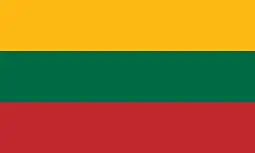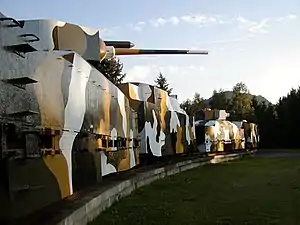Zvolen
Zvolen (pronounced [ˈzʋɔlen] ⓘ; Hungarian: Zólyom; German: Altsohl) is a town in central Slovakia, situated on the confluence of Hron and Slatina rivers, close to Banská Bystrica. It is surrounded by Poľana mountain from the East, by Kremnické vrchy from the West and by Javorie and Štiavnické vrchy from the South.
Zvolen | |
|---|---|
City | |
 Coat of arms | |
 Zvolen Location of Zvolen in the Banská Bystrica Region  Zvolen Location of Zvolen in Slovakia | |
| Coordinates: 48°34′14″N 19°07′3″E | |
| Country | Slovakia |
| Region | Banská Bystrica |
| District | Zvolen |
| First mentioned | 1135 |
| Government | |
| • Mayor | Lenka Balkovičová |
| Area | |
| • Total | 98.72[1] km2 (38.12[1] sq mi) |
| Elevation | 374[2] m (1,227[2] ft) |
| Population (2021) | |
| • Total | 40,239[3] |
| Time zone | UTC+1 (CET) |
| • Summer (DST) | UTC+2 (CEST) |
| Postal code | 960 01[2] |
| Area code | +421 45[2] |
| Car plate | ZV |
| Website | www.zvolen.sk |
The population numbers approximately 40,000, which makes it the twelfth-largest city in Slovakia. It is the center of the Podpoľanie region and the seat of a county (Zvolen District). It is also an important transportation hub in Slovakia.
Etymology
The name is of Slovak (Slavic) origin meaning "the chosen one, splendid, excellent". The Hungarian Zólyom and the German Sohl were derived from the Latinized form Zolium[4] (earliest mention 1135). An adjective "Old" (German: Altsohl, Slovak: Starý Zvolen, Latin: Antiquum or Vetus Solium) distinguish Zvolen from Banská Bystrica (German: Sohl, Neusohl).[4]
History
Zvolen has been inhabited since the Paleolithic. In the ninth century, a Slavic settlement (today the Môťová neighborhood) became a regional center of what is now central Slovakia. Zvolen remained the capital of Zólyom County until the 1760s. In the 11th and 12th centuries, one of the largest medieval castles in Europe, Pustý hrad, was constructed. The town, originally built under the castle, lay on an important trade route (Via Magna) from Buda to Kraków. Zvolen was granted town privileges by King Béla IV in the 1230s - as one of the first towns in the Kingdom of Hungary. The privileges were confirmed on 28 December 1243, after the original document was destroyed in war. Later, King Louis I the Great built a new castle, which became a popular hunting resort of the Hungarian kings. The future queen regnant Mary of Hungary and emperor Sigismund celebrated their wedding there in 1385.
In the Rákóczi's War of Independence the Kuruc army in the battle of Zvolen defeated the enemy forces from Austria, Denmark, Vojvodina and Hungary.
In 1848–49, Ľudovít Štúr was a member of the Diet, with Zvolen as his constituency. In 1871–1872, two new railways were built and Zvolen became an important railroad hub and important industrial center. Zvolen played an important role during the Slovak National Uprising. Two of its armored trains, which were made in the local railway manufactory, Hurban and Štefánik can be seen near the Zvolen castle.
Zvolen is an important railroad, an important road hub and has a large timber factory and a technical university, the Technická univerzita vo Zvolene. An airport in nearby Sliač used to offer direct flights to Prague, but has been used exclusively by the military since 2021.[5]
The town square was modernized in 2002 and local businesses are popular with tourists. In wintertime an ice rink is constructed in the center and festive celebrations run throughout December.
Demographics
Zvolen has a population of 43,147 (as of 31 December 2005).[6] According to the 2001 census, 95.9% of inhabitants were Slovaks and 1.2% Czechs. The religious make-up was 52.5% Roman Catholics, 26.4% people with no religious affiliation, and 15% Lutherans.[6]
Sport
The local ice hockey team HKm Zvolen plays in the Slovak Extraliga.
Notable people
- Bálint Balassi (1554–1594), poet and nobleman
- Karol Beck (born 1982), tennis player
- Michal Chovan (born 1987), ice hockey player
- Jozef Cíger-Hronský (1896–1960), writer
- Dalibor Dvorský (born 2005), ice hockey player
- Rebeka Jančová (born 2003), alpine skier
- Elena Kaliská (born 1972), slalom canoeist
- Milan Lasica, (1940–2021), actor
- Ján Lašák (born 1979), ice hockey player
- Vladimír Mečiar (born 1942), politician, PM (1990-1991, 1992-1994, 1994-1998)
- Ľudovít Štúr (1815–1856), politician, linguist, writer
- František Velecký (1936–2003), actor
- Peter Zuzin (1990), ice hockey player
Twin towns — sister cities
Zvolen is a member of the Douzelage, a town twinning association of towns across the European Union. This active town twinning began in 1991 and there are regular events, such as a produce market from each of the other countries and festivals. As of 2019, its members are:[7]
 Agros, Cyprus
Agros, Cyprus Altea, Spain
Altea, Spain Asikkala, Finland
Asikkala, Finland Bad Kötzting, Germany
Bad Kötzting, Germany Bellagio, Italy
Bellagio, Italy Bundoran, Ireland
Bundoran, Ireland Chojna, Poland
Chojna, Poland Granville, France
Granville, France Holstebro, Denmark
Holstebro, Denmark.svg.png.webp) Houffalize, Belgium
Houffalize, Belgium Judenburg, Austria
Judenburg, Austria Kőszeg, Hungary
Kőszeg, Hungary Marsaskala, Malta
Marsaskala, Malta Meerssen, Netherlands
Meerssen, Netherlands Niederanven, Luxembourg
Niederanven, Luxembourg Oxelösund, Sweden
Oxelösund, Sweden Preveza, Greece
Preveza, Greece Rokiškis, Lithuania
Rokiškis, Lithuania Rovinj, Croatia
Rovinj, Croatia Sesimbra, Portugal
Sesimbra, Portugal Sherborne, England, United Kingdom
Sherborne, England, United Kingdom Sigulda, Latvia
Sigulda, Latvia Siret, Romania
Siret, Romania Škofja Loka, Slovenia
Škofja Loka, Slovenia Sušice, Czech Republic
Sušice, Czech Republic Tryavna, Bulgaria
Tryavna, Bulgaria Türi, Estonia
Türi, Estonia
 Imatra, Finland
Imatra, Finland Zwoleń, Poland
Zwoleń, Poland Prachatice, Czech Republic
Prachatice, Czech Republic Tótkomlós, Hungary
Tótkomlós, Hungary Rivne, Ukraine
Rivne, Ukraine
Gallery


 Armored train Hurban
Armored train Hurban City centre of Zvolen
City centre of Zvolen
 Zvolen in 1596
Zvolen in 1596
 Slatina river in Zvolen
Slatina river in Zvolen
References
- "Hustota obyvateľstva - obce [om7014rr_ukaz: Rozloha (Štvorcový meter)]". www.statistics.sk (in Slovak). Statistical Office of the Slovak Republic. 2022-03-31. Retrieved 2022-03-31.
- "Základná charakteristika". www.statistics.sk (in Slovak). Statistical Office of the Slovak Republic. 2015-04-17. Retrieved 2022-03-31.
- "Počet obyvateľov podľa pohlavia - obce (ročne)". www.statistics.sk (in Slovak). Statistical Office of the Slovak Republic. 2022-03-31. Retrieved 2022-03-31.
- Štefánik, Martin; Lukačka, Ján, eds. (2010). Lexikón stredovekých miest na Slovensku [Lexicon of Medieval Towns in Slovakia] (PDF) (in Slovak). Bratislava: Historický ústav SAV. p. 564. ISBN 978-80-89396-11-5.
- "Vláda rokuje o zrušení spoločnosti Letisko Sliač, pre dve ďalšie spoločnosti plánuje investičný stimul". www.noviny.sk (in Slovak). 10 February 2021. Retrieved 14 August 2023.
- "Municipal Statistics". Statistical Office of the Slovak republic. Archived from the original on 2007-04-27. Retrieved 2007-05-03.
- "Member towns". Douzelage. Retrieved 2019-08-20.
- "Partnerské mestá" (in Slovak). Zvolen. Retrieved 2019-09-01.
_-_city_center.jpg.webp)
.jpg.webp)

.jpg.webp)